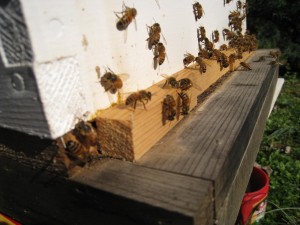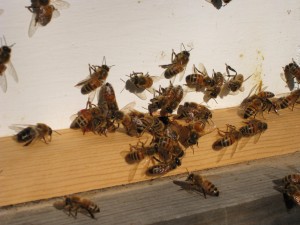What follows are some notes from Keith Tignor, Virginia’s Bee King, at the East Richmond Beekeeper’s association meeting this past week. In addition, I have added a few notes from the Oct 2009 American Bee Journal. These things will presumably give my bees a leg up on the coming Winter.
Each hive needs 60 lbs of honey for a good Winter. I think I have heard this dozens of times. It really makes me chuckle. What the heck is 60# of honey!? I am willing to bet that anyone who knows what this is, already knows how much the bees need for the Winter! I am sure my neighbors will get a chuckle when I take the bathroom scale out to the bee yard.
Combine the weak hives. Although I only have one weak hive and one strong, Keith recommended combining your weak hives, only to divide them again in the Spring. It is tough for a weak hive to make it through the Winter, but much easier for a really strong (combined hive.) So, pinch the queen (the hive is weak because of the queen, typically) and drop those bees in with some others. The odds of me getting that one right are low at this point, so I am simply going to try to get the weak one through the Winter. In future years, I will convert to this practice.
Winter guests. Mice love to stay in the hive for the winter, enjoying some warmth and a tasty honey meal at their whim. Need to get the entrance reducers in place to prevent this.
Ventilation. During the Winter, the warmth of the bees will cause moisture to form about the cluster. This moisture is apparently a real problem for the bees, as the condensation will coalesce into water that drips down right onto the cluster. That is pretty much a death sentence for the bees.
So, you battle this with a little ventilation. None of this was particularly knew to me, except for Keith’s suggesting to use something that is only a quarter of an inch wide. Since I use a Top feeder on my weaker hive, the suggestion to put a spacer under the telescoping cover will not work for me. But, Keith immediately recommended simply putting a quarter-inch spacer between the feeder and the top brood chamber.
He also was pretty adamant about covering up the screened bottom board. I need to remember that the exact opposite recommendation was given by one of the beekeeper’s in the ERBA (he suggested keeping the bottoms open). Testing something like this would be too difficult for me at this point, but I am thinking that I am going to follow Keith’s suggestion. It’s really a question of comfort (my own!) I have a real problem thinking about that open bottom board. It reminds me of a winter camping trip that I took into the mountains. Having a shelter with a huge open in the bottom would have frozen my bottom off! Closing that up will give me a peace of mind.
Pollen: On Jan 1, it is important that the bees have 5 frames of pollen. Either I do not know what pollen is or my very strong hive did not pack enough pollen. Five whole frames of pollen!? I have it all allong the edges of several frames, but I definitely do not have 5 frames of it. This tip is probably an error.
Regardless, the key point to remember here is that the bees need protein starting in January for the brood build up. This is a very good time to place some pollen substitute on top of the brood.
Don’t break the cluster. When you are examining the hive during one of the warmer days of Winter, do NOT break the cluster. This was a really good bit of information, as I can guarantee that I would have done exactly that. Basically, the point of the inspection is to make sure there is some honey next to the cluster (move it if there is not) and that they have a little pollen. Leave the center frames alone (assuming this is where the cluster is.)
Other comments included…
Nectar flow: This really had nothing to do with Keith’s subject, but it was a bit of knowledge that I definitely did not have. According to Keith, we are lucky if we can get One good nectar flow a year. In my reading, there was a
American Foulbrood : This has nothing to do with winterizing, but Keith Tignor spoke about some of the many bee pests (his Doom and Gloom talk) and one touched on this problem. The main thing that I want to note about this regards his recommendation on frame replacement. Basically, A Foulbrood spore build up over time in the wax. A strong hive is resistant, but why expose them to this spore (at a greater and greater intensity as time goes on)?
The key is to replace your frames every 3 years. Just take the old ones and burn them. I need to start dating my frames…
Varoa Mites : Keith made a fairly interesting point about Mite location. At any given time, only about 30% of them are out on the bees. The rest are in the brood cells, multiplying like rabbits. That’s why it is somewhat pointless to treat only once or twice. You really should try to hit them with powdered sugar 4 or more times, at about 1 every week.
Keith also suggested using a pound of sugar each time you treat them.


